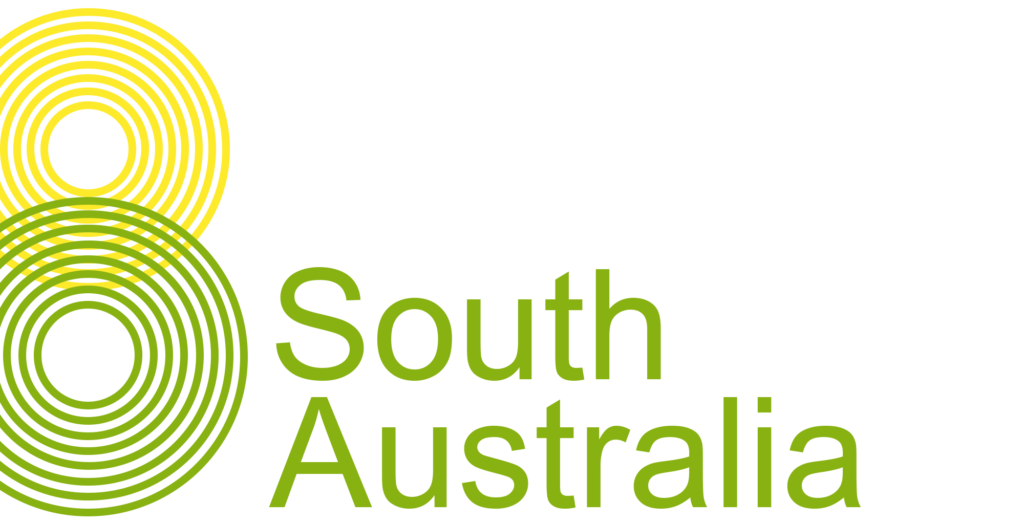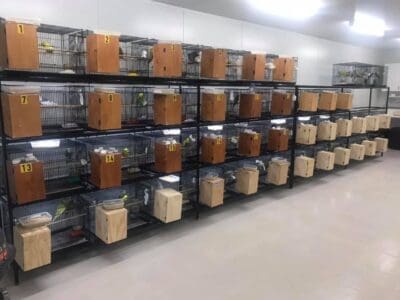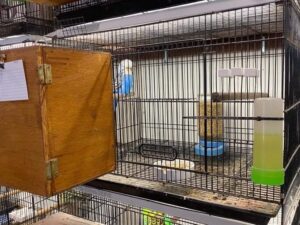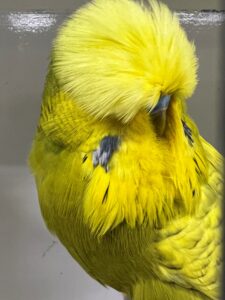
Infertility in Budgerigars
In ‘The Challenge,’ Gerald Binks identifies twenty factors that may contribute to infertility in budgerigars. To a point, these factors have stood the test of time.
Failure to Mate
To increase breeding success, it is important to select the most alert and active birds from our stock that exhibit a strong desire to mate, as not all birds possess the same level of enthusiasm. Budgerigars that are timid and uninterested in mating typically have higher rates of infertility. Additionally, providing good nutrition is crucial for optimal nest box performance.
Immature Parents
Although some birds may display eagerness to breed even when they are still juveniles, it is unfair to expect them to do so, regardless of their size. Even if they are capable of mating, laying eggs, and incubating, the responsibility of nurturing and feeding a brood of chicks can be overwhelming for young birds. Furthermore, early egg-laying can have negative effects on a hen’s health. It’s worth noting that some rarer variety breeds may have a longer maturation period compared to more common varieties when selecting breeding pairs.
Unsuitable Perches
 Gerald Binks recommends using square hardwood perches instead of round ones because male cock birds may find it difficult to mount hens on smooth round perches. This is a common cause of infertility in budgerigars. Naturally, the issue is more prevalent with larger hens than smaller ones. Some breeders have observed that determined birds will find a way to mate regardless. That being said, uneven perches have been blamed for failed mating attempts. Some breeders will install a double perch, an inch apart. To this end, bigger hens are able to lay across this while the male performs his duties.
Gerald Binks recommends using square hardwood perches instead of round ones because male cock birds may find it difficult to mount hens on smooth round perches. This is a common cause of infertility in budgerigars. Naturally, the issue is more prevalent with larger hens than smaller ones. Some breeders have observed that determined birds will find a way to mate regardless. That being said, uneven perches have been blamed for failed mating attempts. Some breeders will install a double perch, an inch apart. To this end, bigger hens are able to lay across this while the male performs his duties.
Overweight Hens
Excessive weight around the back of the body can pose a challenge to breeding for hens, regardless of their size. This weight gain is usually a result of inactivity and can lead to difficulty in successful mating and egg laying. The extra weight restricts the oviduct and will hinder the process. Additionally, tumors in this region can also have similar effects, causing infertility in budgerigars.
Infertility in Male Budgerigars
If a cock has matured normally, he may still be physically incapable of fertilising eggs or have weak sperm. Alternatively, he may be physically healthy but lack experience in mating, particularly if he is low in the pecking order in the aviary. If a bird has been frequently exhibited, it may become infertile due to stress. According to Dr. Baker, few cocks are genuinely sterile, but there may be periods in their reproductive cycle when they do not produce sperm. Fanciers have noticed that males typically cycle, having six weeks of sperm, followed by two weeks of no sperm, and then back to six weeks of sperm. Males also generally stop producing sperm while they are feeding chicks. For this reason, if a hen starts laying early, the second round of eggs can sometimes be infertile.
Genetic Variables
Selective breeding for desirable traits over many generations can lead to the concentration of genes for undesirable traits, including weak sperm production. Dr. Harry Cooper emphasizes that when birds mate from a diverse gene pool, there is “hybrid vigor,” while inbreeding can lead to the opposite effect. Thus, it is important to carefully examine our inbreeding and line breeding practices to ensure that we have not unintentionally bred infertility into our stock. Even the best bird in the show is of little value if it cannot reproduce.
When many close pairings are made, it is recommended to judiciously use outcrosses to maintain a specific variety. Notably, this especially applies to the rare ones where the entire breeding program may depend on a single bird. In a recent presentation to the BSSA, Troy Holmes noted that his experience with sperm under the microscope suggested that different families had different sperm counts, and that sperm could last for varying amounts of time. This variation was common, but notably similar in genetic families (studs) of birds.
Inadequate Lighting and Temperature
In our climate, we are fortunate not to face the same issue as breeders in colder countries where breeding rooms require heating and lighting due to the shorter daylight hours. Providing enough daylight is crucial for the birds to have ample time to feed their offspring during the breeding process. Unlike in colder countries, our climate provides enough natural daylight for the birds to complete their tasks without requiring additional lighting. Studies indicate that birds adapt to the natural light cycle, so leaving lights on beyond natural daylight hours is unnecessary.
Exhausted or Out of Condition Birds
Birds may experience stress and exhaustion due to various factors, such as lack of food, excessive exhibition, or parasitic infections, which can affect their breeding behavior. If left without food even for a short time, birds can become stressed and may not have the energy to initiate breeding. Similarly, parasites can cause birds to be restless at night, leading to exhaustion that may reduce their interest in breeding. Therefore, it is important to provide birds with adequate nutrition, minimize exhibition stress, and ensure that they are free from parasites to optimize their breeding potential.
Birds in Poor Condition
Male birds have a reproductive cycle that includes periods when they are not producing any sperm. Therefore, if they are not in breeding condition when they are paired up with a female (and if they are able to mate at all), infertile eggs will result. In addition, if a hen is out of condition, she may show no interest in the nest box whatsoever. It is crucial that the hen reaches the stage where there is a noticeable change in her droppings. This indicates that she is in condition and ready to lay eggs. If she does not reach this stage within 3 weeks of pairing, she should be returned to the flight.
Aviary is Too Quiet
Budgerigars naturally breed in colonies as they are social birds that are stimulated by the noise of others. For beginners with only a few birds, breeding can be challenging as a single pair of birds is unlikely to breed successfully. Some breeders have suggested wire cabinets as a solution, as they allow birds to see each other and promote breeding. However, other breeders argue that wooden box type cabinets are equally effective. Ultimately, it seems that the noise factor is more important than the visual factor in promoting breeding behavior.
Hen’s That Confine Themselves to a Nest Box
 A hen entering the breeding box and not coming out to be fertilised is a condition. Fancier’s refer to this as ‘going to nest’ or ‘box bound’. Sometimes, a hen may behave this way due to anxiety or stress during the initial pairing process. She effectively hides from her male mate in the nest box, but the end result is budgerigar infertility. Alternatively, a hen may behave well during the first round but refuse to come out of the box for subsequent rounds. Having the first-round chicks still in the box can be one of the causes of this behavior, as hens often dislike mating in a distracting situation.
A hen entering the breeding box and not coming out to be fertilised is a condition. Fancier’s refer to this as ‘going to nest’ or ‘box bound’. Sometimes, a hen may behave this way due to anxiety or stress during the initial pairing process. She effectively hides from her male mate in the nest box, but the end result is budgerigar infertility. Alternatively, a hen may behave well during the first round but refuse to come out of the box for subsequent rounds. Having the first-round chicks still in the box can be one of the causes of this behavior, as hens often dislike mating in a distracting situation.
There are several techniques for keeping a hen out of the box to mate, including closing off the box for a short time, using stoppers or crumpled paper to block the hole to the nest box, or removing the box entirely. Different breeders use different techniques, but all with the same purpose of excluding the birds from the box for 24 hours or until they show signs of getting together. Closing the nest box off overnight and then opening it again a couple of hours after dawn is another suggestion. This forces the pair to spend time together, and hopefully, leads to them mating.
The presence of the nest box is one of the factors that sets a pair into “breeding mode”. A breeder may suggest placing a pair of budgerigars in a cabinet with a nest box to pique their interest in breeding. The nest box can then be removed for a few days so that the birds focus on each other, and it can be reintroduced once the birds have mated.
Highly Agitated Hens
According to Gerald Binks, hens with a tendency to panic during mating can be a significant problem in breeding situations. This behavior can cause disturbance throughout the aviary, much akin to a screaming baby at a restaurant. Additionally, their anxiety can lead them to panic in the nest box, resulting in the destruction of their eggs. Even if they manage to have offspring or foster them, their anxious behaviour can be passed down to their offspring, as behaviours are often genetic.
Disturbance – Pests or External Lighting
Vermin that roam around freely can pose a threat to health and also disturb birds, making them restless and agitated. This, in turn, can lead to fatigue during the day and negatively impact their breeding abilities, as the tired budgerigar isnt that interested in breeding. This results in clear eggs due to budgerigar infertility, most likely because the bird hasn’t mated. Another factor that can be unsettling for birds is flashing lights, such as those from nearby houses or passing cars. It may be necessary to install blinds or shutters to prevent this issue from arising.
Infected Embryos
In the breeding process, second or third round eggs can become covered in droppings, leading to potential problems. As eggshells are porous, bacteria can pass into the egg, causing it to become addled. To prevent this, breeders must thoroughly clean the nest boxes between rounds and put in new false bottoms for the next round. You must take caution not to scrape off caked droppings while washing the eggs with warm water if cleaning is necessary. This is because it can harm the egg.
Breeder handling of eggs can also cause infection, so always wash your hands thoroughly before touching eggs. Research conducted by Dr. Baker revealed that staphylococcal infection was a leading cause of dead in shell, which is rarely found in droppings but commonly found on human skin, including hands. Thus, Dr. Baker recommended minimizing egg handling as much as possible. You must return the eggs precisely as they were after marking to avoid disturbing the hen’s behavior. Hens turn the eggs during the day and have a memory of the order in which they placed them.
Feathering that is Buff
 Buff feathering refers to the dense and rough plumage that can give birds a bulky appearance. However, this type of feathering can make breeding challenging as the thick feathers around the vent area can hinder successful mating and fertilisation, making it difficult to produce viable offspring. Many breeders recommend against mating buff to buff feathered birds, as it can increase the likelihood of budgerigar infertility. Trimming the feathers around the vent area is a possible solution to this problem. Both males and females can undergo this process to improve the number of fertile eggs.
Buff feathering refers to the dense and rough plumage that can give birds a bulky appearance. However, this type of feathering can make breeding challenging as the thick feathers around the vent area can hinder successful mating and fertilisation, making it difficult to produce viable offspring. Many breeders recommend against mating buff to buff feathered birds, as it can increase the likelihood of budgerigar infertility. Trimming the feathers around the vent area is a possible solution to this problem. Both males and females can undergo this process to improve the number of fertile eggs.
Negative side effects from Medications
The administration of certain drugs for the treatment or prevention of illnesses can lead to temporary infertility in male budgerigars. Good husbandry practices do not recommend breeding birds after an illness. Advisors recommend providing birds with a period of proper feeding and rehabilitation before pairing them up for breeding. Breeders must consider the type and duration of the illness and make a decision on whether it is wise to breed a bird that has been affected. It may be best to avoid breeding altogether with a bird that has been impacted by a particular illness.
Hens that are Internal Layers
The term “internal layers” refers to a condition in hens where they prepare to lay eggs by experiencing swelling around the vent area and producing large droppings similar to those of brooding hens. However, in this case, no eggs appear due to a malfunction of the shell gland. The egg is partially re-absorbed, and the remaining part passes out in the droppings. Feeding increased calcium usually does not have any effect, but it is worth a try. Breeders can give a first-time laying hen another chance to breed the following year.
According to Dr. Harry Cooper, several abnormalities in a hen can lead to the ova not passing down the oviduct or not forming a normal egg. Sometimes a large cyst forms in the oviduct and blocks any sperm from coming up and ova from passing down. Hormone levels can also affect successful egg production, as a hen may have one hormone level that allows her to mate but lack another that would lead her to produce eggs. Experienced breeders can detect external anomalies such as hernias or pelvic abnormalities that may lead to the failure of egg laying.
Pairing on the Decline
The timing of the moult can affect a bird’s fitness cycle and result in budgerigar infertility. However, with unpredictable weather patterns, it can be difficult to determine the appropriate time for pairing. It is important for birds to be in peak condition before pairing, which usually means they should have completed the moult and be heading towards their peak. Gerald Binks recommends waiting until birds are at least three quarters of the way towards their peak. The condition of a hen’s cere can also indicate her readiness to pair. When the cere is a clear light brown, the hen is ready. In contrast, when it becomes really dark brown, she is past her prime. Dr. Harry Cooper notes that producing new feathers requires a lot of a bird’s resources. To that end, it makes it difficult for moulting budgerigars to breed successfully during this time.
Old Age
Experienced breeders believe that birds can continue breeding even at an advanced age. Typically, male budgerigars start breeding at six months and can continue up to four years. Meanwhile, females are considered to be most fertile during their second and third years. Although it used to be common for breeders to have success with six-year-old birds, this is becoming increasingly rare. Older birds may still produce offspring, while others may have passed their prime and are no longer capable of breeding. Ultimately, the decision of when to retire a bird from breeding is up to the individual breeder. It depends on various factors such as health, breeding history, and overall condition. However, the breeder needs to be aware that as age increases, so does the chances of budgerigar infertility.
The Breeding Pair may not Synchronise Their Conditions
Pairing birds for breeding can be a challenging task for the breeder. The exacerbation of this is when the desired pair is not ready to breed at the same time. In such cases, the breeder must make a decision. Should they pair the ideal couple and risk ending up with mostly clear eggs? Or should they compromise and choose a second-best mate for the bird who is in peak condition? This may ultimately result in a full nest of chicks. Opting for the latter increases the chances of having good birds in the nest while maintaining the fertility. Ultimately, the breeder must weigh their options and make the best decision based on their breeding goals and priorities.
